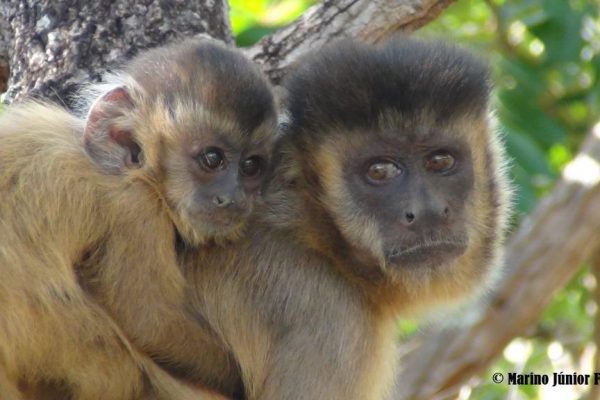
Species description and distribution
Tufted capuchin monkeys are robust, medium-size Neotropical primates, with a relatively short and semi-prehensile tail. They are found east of the Andes from Colombia and Venezuela to Paraguay and northern Argentina. The fur colour and tuft shape vary locally (Torres de Assumpção 1983).
Bearded capuchin monkeys, Sapajus libidinosus, belong to the tufted group of capuchin monkey species (Rylands et al. 2000; Silva Júnior 2001). It occurs in the central portion of the tufted species geographic distribution, in areas of the Atlantic, Caatinga, and Cerrado domains (Silva Júnior 2001). The colour varies from light brown to yellow; the cap is brown, short with two tufts.
Recent molecular analysis has revealed that capuchin monkeys, formerly identified as the single genus Cebus, are two genera, with the robust (tufted) forms (including libidinosus, xanthosternos, apella and several other species) now recognized as the genus Sapajus, and the gracile forms retained as the genus Cebus (Lynch Alfaro et al. 2012). The nomenclature for Sapajus is registered with ZooBank (urn:lsid:zoobank.org:act:3AAFD645-6B09-4C88-B243-652316B55918). Therefore, the species name of the bearded capuchins that we study changed from Cebus libidinosus to Sapajus libidinosus.
We decided for now not to change the name of our project to reflect this change in nomenclature because the general public still identifies tufted capuchins as Cebus monkeys.
Ecology
Capuchin monkeys are omnivorous, but their main food source is the pulp of mature soft fruits, complimented with invertebrate prey and other plant parts, such as seeds, flowers and stems. In habitats or times of fruit scarcity, they intensify the consumption of these alternative resources (Terborgh 1983, Spironello 1991, Peres 1994, Galetti & Pedroni 1994, Zhang 1995, Brown et al. 1986, Brown & Zunino 1990, Rímoli 2002, Izar 2004). Occasionally they can prey on small vertebrates, like birds (Ferreira et al. 2001), rodents (Galetti 1990; Resende et al. 2002) and smaller primate species (Sampaio & Ferrari 2005).
Up to now, S. libidinosus is the only species in which the use of tools in the wild to crack-open nuts (Fragaszy et al. 2004) and to feed on embedded resources like insect nests (Moura & Lee 2004; Mannu & Ottoni 2005) has been the object of systematic, long-term studies.
The variability of foraging strategies reflects in variability of ranging behaviour. Ranging behaviour and home range size are affected by fruit availability and distribution (Zhang 1995, Spironello 2001, Izar 2004), and to group size (Di Bitetti 2001, Izar 2004).
Social behaviour
Capuchin monkeys groups can be characterised as multimale-multifemale, with typically more adult females than adult males, and group size varies widely across study sites. In most studies, groups are very cohesive during all activities (Robinson & Janson 1987), but populations from Atlantic Forest may split into subgroups during foraging activities, in a manner closer to fission-fusion societies (Lynch 2001, Izar 2004).
Female philopatry and male dispersal is the norm for capuchin monkeys. Females may disperse from natal groups, through permanent group fission, accompanied by kin, if group size reaches an upper limit when group competition increases above the equilibrium level (Izawa 1994, Di Bitetti 2001). In Atlantic Forest females, besides males, may actually live their natal group and enter a group with likely unrelated females, for example, after a male take-over of the original groups, or after periods of fruit scarcity (Lynch and Rímoli 2000, Izar 2004).
Dominance relationships within-group are organized into linear (Janson 1985) or partial (Izar et al. 2006) hierarchies, with typically one large adult male being the most dominant group member. Dominance hierarchy affects the spatial organization of groups during foraging activities (Janson 1990 a, b), with dominant members and immature occupying the most privileged positions in terms of foraging success and predation risk avoidance.
Male status affects also their reproductive success.The mating behaviour of tufted capuchin monkeys is characterised by the active choice of estrous females, following the adult male, usually the dominant one, resulting in almost exclusivity of reproductive success (Janson 1984). It is interesting to note that females may present proceptive behaviour outside the cycling phase, even lactating females, when new males enter the group, or when they are entering a new group. Thus Carosi & Visalberghi (2002, Carosi et al. 1999) suggest that proceptive behaviour is a way of attracting males. It seems to be advantageous for females to select the dominant male. He controls the access to fruit trees, aggressively displacing group members, more often other adult males (Janson 1990). He can be very tolerant to immatures near him, even carrying some infants and often baby sitting (Izar & Sato 1997). And, in Atlantic Forest, he controls the joining of new females to a social group, that occurs after copulation with him (Izar 2004).
References
Di Bitetti, M.S. (2001). Home-range use by the tufted capuchin monkey (Cebus apella nigritus) in a subtropical rainforest of Argentina. J. Zool. Lond., 253, 33-45.
Brown, A.D., & Zunino, G.E. (1990). Dietary variability in Cebus apella in extreme habitats: Evidence for adaptability. Folia Primatologica, 54, 187-195.
Brown, A.D., Chalukian, S.C., Malmierca, L.M., & Colillas, O.J. (1986). Habitat structure and feeding behavior of Cebus apella (Cebidae) in El Rey National Park, Argentina. In: Current Perspectives in Primate Social Dynamics. D.M. Taub ; F.A. King, eds. Van Nostrand Reinhold Company, New York.
Carosi, M., & Visalberghi, E. (2002). Analysis of tufted capuchin (Cebus apella) courtship and sexual behavior repertoire: Changes throughout the female cycle and female interindividual differences. American Journal of Physical Anthropology, 118, 11-24.
Carosi, M., Heistermann, M. & Visalberghi, E. (1999). The display of proceptive behaviors in relation to urinary and fecal progestin levels over the ovarian cycle in female tufted capuchin monkeys. Horm Behav, 36, 252-265.
Ferreira, R. G., Resende B. D., Mannu, M., Ottoni, E. B., & Izar, P. (2002). Bird predation and prey-transference in Brown Capuchin Monkeys (Cebus apella). Neotropical Primates, 10, 84-89.
Galetti, M., & Pedroni, F. (1994). Seasonal diet of capucchin monkeys (Cebus apella) in a semi-deciduous forest in south-east Brazil. Journal of Tropical Ecology,
Galleti, M. (1990). Predation on the squirrel, Sciurus aestuanus by capuchin monkeys, and Cebus apella. Mammalia, 54, 152-154.
Izar, P. (2004). Female social relationships of Cebus apella nigritus in southeastern Atlantic Forest: an analysis through ecological models of primate social evolution. Behaviour, 141, 71-99.
Izar, P.; Sato, T. (1997) - Influência de abundância alimentar sobre a estrutura de espaçamento interindividual e relações de dominância em um grupo de macacos-prego (Cebus apella). In: APrimatologia no Brasil 5. Ferrari, S. ; Schneider, H. eds., Belém, PA.
Izar, P., Ferreira, R.G., Sato, T (2006). Describing the organization of dominance relationships by Dominance Directed Tree method. American Journal of Primatology, 68,189 - 207.
Izawa, K. (1994). Group division of wild black-capped capuchins. Field Studies of New World Monkeys, La Macarena, Colombia, 9, 5-14.
Janson, C.H. (1984). Female choice and mating system of the brown capuchin monkey Cebus apella (Primates: Cebidae). Z. Tierpsycol, 65, 177-200.
Janson, C.H. (1990 a). Social correlates of individual spatial choice in foraging groups of brown capuchin monkeys, Cebus apella. Animal Behaviour, 40, 910-921.
Janson, C.H. (1990 b). Ecological consequences of individual spatial choice in foraging groups of brown capuchin monkeys, Cebus apella. Animal Behaviour, 40, 922-934.
Lynch, J.W. & Rímoli, J. (2000). Demography and social structure of group of Cebus apella nigritus (Goldfuss, 1809, Primates/Cebidae) at Estação Biológica de Caratinga, Minas Gerais. Neotropical Primates, 8(2), 44-49.
Lynch, J.W. (2001). Male behavior and endocrinology in wild capuchin monkeys, Cebus apella nigritus. Unpublished Doctoral Thesis.University of Wisconsin, Madison.
Peres, C.A. (1994). Primate responses to phenological changes in an Amazonian terra firme forest. Biotropica, 26(1), 98-112.
Resende, B. D. Greco, V. L. G., Ottoni, E. B., Izar, P. (2002). Some observations on the predation of small mammals by tufted Capuchin Monkeys (Cebus apella). Neotropical Primates, 11, 103-104.
Rímoli, J. (2001). Ecologia de macacos-prego (Cebus apella nigritus, Goldfuss, 1809) na Estação Biológica de Caratinga (MG): implicações para a conservação de fragmentos de Mata Atlântica. Unpublished Doctoral Thesis. Biological Sciences, University of Pará, Belém.
Robinson, J.G. & Janson, C.H. (1987). Capuchins, squirrel monkeys and atelines: socioecological convergence with Old World primates. In: Primate Societies(B.B. Smuts, D.L. Cheney, R.M. Seyfarth, R.W. Wrangham & T.T. Struhsaker, eds). University of Chicago Press, Chicago, 69-82.
Rylands, A.B., Schneider, H., Langguth, A., Mittermeier, R.A., Groves, C.P. and Rodríguez-Luna, E. (2000). An assessment of the diversity of New World monkeys. Neotropical Primates, 8, 61-93.
Sampaio DT, Ferrari SF. (2005). Predation of an infant titi monkey (Callicebus moloch) by a tufted capuchin (Cebus apella). Folia Primatol, 76, 113-115.
Silva Júnior, J.S. (2001). Especiação nos macacos-prego e cairaras, gênero Cebus Erxleben, 1777 (Primates, Cebidae). Unpublished Doctoral Thesis. Genetics. Federal University of Rio de Janeiro.
Spironelo, W.R. (1991). Importância dos frutos de palmeiras (Palmae) na dieta de um grupo de Cebus apella (Cebidae, Primates) na Amazônia Central. In:A Primatologia no Brasil, vol. 3.
Spironello, W.R. (2001). The brown capuchin monkey (Cebus apella). Ecology and home range requirements in Central Amazonia. In: Lessons from Amazonia: The ecology and conservation of a fragmented forest (R.O. Bierregaard, C. Gascon Jr., T.E. Lovejoy & R Mesquita., eds). Yale University Press, New Haven & London, 271-283.
Terborgh, J. (1983). Five New World monkeys. Princeton University Press, Princeton.
Torres de Assumpção, C. (1983). An ecological study of primates of Southeastern Brazil with a reappraisal on Cebus apella races. PhD Thesis. Edinburgh University.
Zhang, S. (1995). Activity and ranging patterns in relation to fruit utilization by brown capuchin monkeys (Cebus apella) in French Guiana. International Journal of Primatology, 16(3), 489-507.


